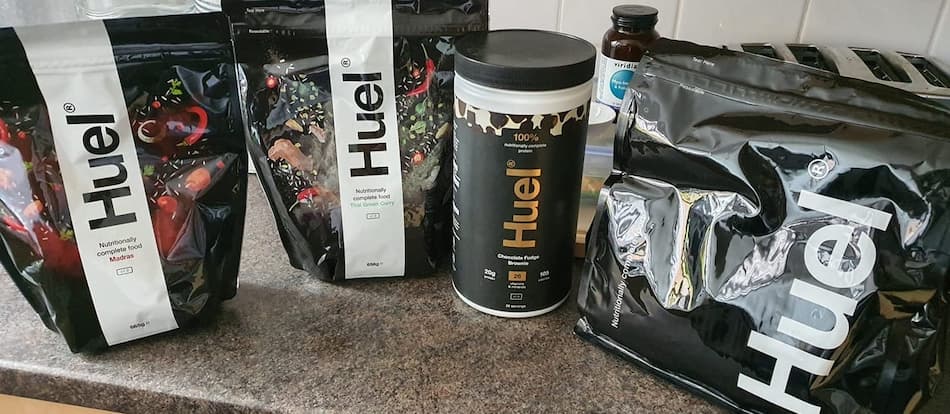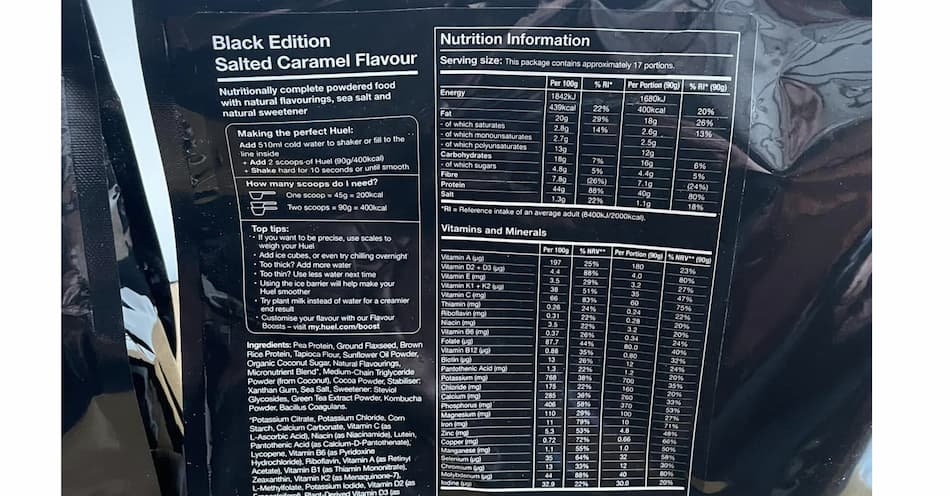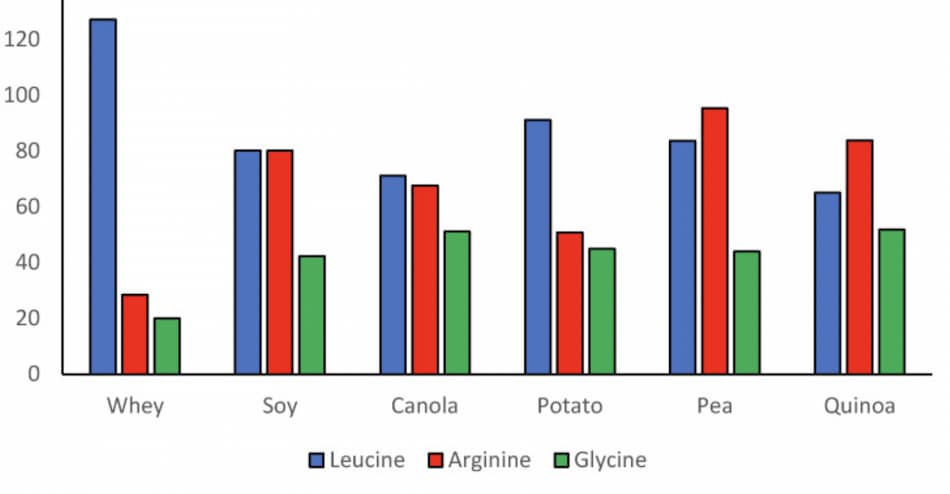Huel was first introduced in 2015 as a vegan-friendly plant-based meal replacement solution with a complete list of macro and micronutrients. Animal-based whey protein was used since the 1950s, firstly as a bodybuilding product to enhance muscle mass, and later as a weight loss meal.

Huel and whey protein are completely different supplements but share one thing in common; they both can be used as a meal replacement. They both have advantages and disadvantages compared to other powders, and both are available in a similar price range.
I will briefly cover the use of both shakes and help you decide which one is better for you, based on your fitness goals.
What’s the difference between Huel and protein powder?
As much as meal replacements aren’t the ideal way to lose weight, they become more popular due to the convenience they offer.
Both Huel and whey protein shakes can be used as an alternative to the so-called “conventional” weight loss programs. The difference is that one serving of Huel delivers over 400 calories, whereas protein powder has four times less (more on that later).
Huel shakes work as an alternative to whole foods. Instead of eating three meals a day, you can replace 1-2 meals with shakes or instant meals. This not only reduces the number of calories you eat but also helps you to save time that you would spend on cooking.
Plus, instead of counting calories, measuring portions, and logging your food intake, Huel offers a convenient way to control how much food you eat.
On the other hand, the goal of the protein shake is to increase amino acid intake.
Huel has more nutrients than protein powder
One of the biggest differences between Huel and whey protein powder is that protein powders do not have many nutrients, compared to Huel. One serving of protein powder has around 30 – 50 mg of sodium and 100 – 150 mg of potassium.
On average, protein powders have between 3 – 11 grams of carbohydrates, and 1 – 4 grams of fat, depending on the brand you choose.
On the other hand, Huel is packed with nutrients, almost like a multivitamin. One serving size contains all 27 essential minerals and vitamins with some reaching up to 80% of the nutrient reference value.
See the picture below.

In the picture, you can see the nutritional label of Huel Black Edition.
What I like about the Huel is that each serving contains around 18 grams of fat, which is essential to digest fat-soluble vitamins. Without the presence of fat in the meal, the body can’t properly absorb the fat-soluble vitamins.
Another thing that I like is that Huel has a high amount of vitamins per serving.
Huel shakes are nutritionally complete becasue one 90-gram serving contains all of the essential micro and macronutrients. Most of the vitamins are in the range of 20 – 30% of RDA, whereas Vitamin D3 and C go as high as 80% of RDA per serving.
On the other hand, there are some situations where taking protein powder alone is more useful, compared to a complete meal (e.g. post-workout, cooking, baking).
From the nutrients perspective, Huel shakes are better than whey protein powders because they have much more nutritional value and can be used as a meal replacement.
NOTE: More nutrients and plant-based protein mean the taste and texture of the shakes can be specific. You can learn more about how to make huel taste better in my article.
Whey protein powder is more effective in building muscle
The difference between Huel complete protein and whey protein powders is that whey protein is animal-based, whereas all Huel products are derived from plant-based sources like pea protein, ground flaxseed, and brown rice protein.
According to the internet, both animal and plant-based proteins are considered “complete”. This means they both contain all essential and nonessential amino acids.
The only difference between plant-based and animal-based proteins is the amino acid ratio.
For a protein to be considered “complete” it has to have adequate levels of amino acids to stimulate muscle protein synthesis, improve net protein balance, support overall growth and development, as well as be readily digested and absorbed.
In other words, it’s not about the presence of amino acids. It’s about a concentration that is high enough to induce metabolic processes.
Take a look at the graph below.

(Image: source)
In the graph above you can see the comparison of some amino acid concentrations between whey and plant-based proteins.
- Leucine – Leucine is one of the branched-chain amino acids that serves as a chef signal for initiating muscle protein synthesis. As you can see, whey protein has on average 35% more leucine than any other protein source.
- Arginine – Arginine is an amino acid responsible for the body’s synthesis of creatine and nitric oxide. It also regulates hormone secretion and helps with immune function. Pea protein has the highest amount of Arginine.
- Glycine – Glycine is an amino acid that is responsible for collagen synthesis. Most plant-based proteins are much higher in glycine than whey protein.
Whey protein is better for muscle building and weight loss
My point is that if your goal is to build strength and maintain lean muscle mass, whey protein powder is much more effective than Huel powders.
One of the downsides of consuming whey protein powders is the environmental footprint.
One study has shown that producing 1 kg of high-quality animal protein requires feeding around 6 kg of plant protein to livestock.
On the scale, this can have a large impact on land and water resources, as well as potential increases in greenhouse gas emissions.
Protein powders do not have Omega 3 fatty acids
One thing that blew me away was that one 90-gram serving of Huel Black Edition contains 5,800 mg of omega-3 fatty acids (which is a big plus). Initially, I got excited becasue I thought I can save money and stop buying Omega 3 from Nordic Natural.
However.
Huel powders do not provide any additional information about the exact ratio. Plus, this is a plant-based company, which means you won’t find any EPA and DHA fatty acids inside the Huel. These fatty acids are only derived from fish oil and grass-fed meats.
All you can find is the plant-based α-linolenic acid. One study has shown that EPA and DHA can improve lipids and inflammation status, whereas ALA cannot.
On the other hand, protein powders don’t have either ALA, EPA, or DHA.
Whey protein powder has fewer calories than Huel
The difference between whey protein and Huel powders is that Huel has four times more calories than regular whey powder. One serving of Huel Black has around 400 calories, whereas one serving of whey protein powder has between 90 – 140 calories.
For people who use Huel as a meal replacement, 400 calorie shake is not that big of a deal.
In fact, one study has shown that a meal replacement intake of around 400 kcal is an effective way to reduce weight and improve body composition, as long as it’s done under supervision and for a short time.
On the other hand, some longitudinal studies (studies that look at the results from the long-term perspective) have shown the opposite effect.
Razk Abdalgwad, MSc M.D. a researcher from the National University of Ireland, said that people who lost a large amount of weight after completing a meal replacement program regain most of the weight within the first 4 years.
According to Dr. Abdalgwad, losing weight is not the biggest challenge. The biggest challenge is maintaining the results over the long term.
In the long term, drinking meal replacements instead of whole foods can get monotonous and boring, which is why most people quit.
You should not use Huel Black as a protein shake
My point is that if you choose to drink Huel, you should not use it as an addition to your regular diet. You should use it as a substitute for one or two meals.
For example, you can use Huel instead of breakfast or lunch, and not as a “snack” in between meals. On the other hand, a protein shake can be used in addition to your regular diet in between your meals.
If your goal is to increase protein intake, without getting more calories, I recommend you chose whey protein.
It is ok to use protein powder as a meal replacement
Protein powders are mainly used as a way to add more proteins to the diet to meet the daily recommended allowance, but they also can be used as a meal replacement.
For example, a physically active male who weighs 190 lbs should consume 160 to 200 grams of protein per day, especially during a calorie deficit.
That’s a lot of food.
Getting so much protein from food can be problematic, so adding 1-2 protein shakes per day helps to fill out the gap.
Protein powders can be consumed on their own, as well as a part of the normal meal (adding protein powder to the cereal bowl or vegetable smoothie) to ramp up the protein intake.
Learn more: Click here to learn more about my top 10 best huel flavors available today.
Conclusion
The difference between whey protein powder and Huel black is that Huel has over 400 calories per serving and comes with multiple macro and micronutrients. It also has plenty of fiber, probiotics, and essential vitamins.
On the other hand, protein powder has more leucine concentration, has fewer calories, and can be consumed in between meals.
The goal of protein powder is to help add more protein to our nutrition, whereas products like Huel work as a complete food replacement.
What I also like about Huel is that all their products are plant-based, which helps to reduce the environmental footprint.
However, multiple studies have shown that animal protein is considered to be a more potent stimulator of muscle protein synthesis, compared to plant-based proteins.

Appreciate the recommendation. Let me try it out.